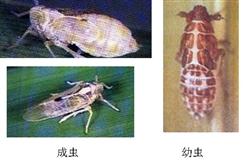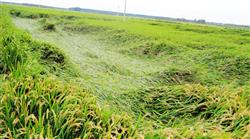How to control rice brown planthopper and white-backed planthopper?

How to control rice brown planthopper and white-backed planthopper? Please introduce the method that brown planthopper occurs at grade 5 in two consecutive years, and has strong resistance to insecticide, while white-backed planthopper occurs in grade 3 to 4 in a row for many years. The main factors affecting the occurrence are migration and climatic conditions in summer and autumn. The outbreak of brown planthopper in Vietnam in the winter of 2006 indicates that there is a large number of insect sources in China this year, but there are no insect-resistant varieties in production at present, coupled with the postponement of rice growth period, it will be beneficial to the later occurrence of brown planthopper. Therefore, if the immigration conditions and summer and autumn climate are suitable in 2007, it is expected that the occurrence of brown planthopper will reach grade 4-5, slightly lighter than last year or similar to last year, and the occurrence area of white-backed planthopper and brown planthopper will reach 75 million mu. In order to control rice planthopper, we should adhere to the control strategy of "control up and down", adjust the kinds of drugs, improve the quality of drug use, and ensure the control effect. The main results are as follows: (1) adhere to the prevention and control strategy of "governance above and pressing down". "governing up and pressing down" is an economic and effective way to control contemporary harm and reduce the pressure of prevention and control of the next generation. in the past two years, our province has always insisted on the control of the fifth (2) generation and the sixth (3) generation of brown planthopper. As a result, the occurrence base of six (3) and seven (4) generations was greatly reduced, the pressure of prevention and control in the later stage was reduced, and the initiative of prevention and control was won. (2) adjust the type of medicine. Due to the high resistance of brown planthopper to imidacloprid, imidacloprid should be discontinued, chlorpyrifos and dichlorvos should be used alternately, new pesticides such as imidacloprid should be demonstrated and promoted, and pyrethroids and methamidophos pesticides should be banned to control the use of triazophos. It should be noted that imidacloprid can still be used in fields dominated by white-backed planthoppers. Can use 5% fipronil 30g 50ml per mu, or 40% chlorpyrifos 80ml 100ml, or 20% isoprocarb 150ml, or 25% buprofezin 50g 60g, plus water spray control. (3) to improve the quality of drug use. Because of the good control effect of chlorpromazine and Ruijin on young nymphs, it is required to control the appropriate period from the peak of egg hatching to the peak of young nymphs, use sufficient water, hit the right position, spray large amount of water, and keep the water layer in the field for a period of time after the medicine. improve the control effect. Such as lack of water in the field, and mainly elderly nymphs and adults, can be fumigated with dichlorvos poisonous soil. Click to get more rice planting techniques click to get more food crop planting techniques
- Prev

How to dry the rice field? What's the use?
How to dry the rice field? What's the use? Please introduce the method of drying rice field is one of the main technical measures to increase yield and promote early maturity of rice. First, the main role of drying field 1, control ineffective tiller, consolidate effective tiller. When the rice tiller has reached a certain number, that is, enough seedlings, our province from the time point of view.
- Next

Why does rice lodge? How to prevent and cure it?
Why does rice lodge? How to prevent and cure it? Please introduce that the earlier the rice lodging occurs, the greater the impact on the yield, the serious plots can reduce the yield by more than 50%, or even cause no harvest. Lodging also has a great impact on rice quality, but also increases the difficulty of harvest. Although rice lodging is related to windy and rainy weather, but the main.
Related
- The first cup of black tea in spring, the flavor and history of tea gardens in Kenya, Africa
- The computer can not only choose potatoes, but also grow tea rice. AI will grow winter oolong tea champion.
- It is not only the inflated tea bitten by insects, but also engraved with the four seasons tea in Beipu.
- The Oriental Beauty Tea Festival in Zhuxian County takes the stage at the weekend to experience the plus-size feast of oil tea.
- & quot; Oriental Beauty Tea & Exploration of Emei in Hsinchu, the hometown of quot;
- The new variety of strawberry "Tainong 1" dessert is the first choice with mellow aroma. Crimson gorgeous
- History of Tea in Taiwan: from Wild Inner Mountain to Export Tea Garden
- Two types of Taiwan Oriental Beauty Black Tea won the British three-Star Award for Childhood Tea Xiang Zhang Jiaqi changed from pilot to champion tea maker.
- Banana species and varieties: the planting history of Taiwan Xianren banana and dwarf banana is long, is banana disease resistant?
- Coffee planting Technology: Qianjie Coffee from Seedling to harvesting

